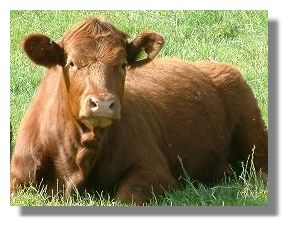Welcome back to Celtophile Monday! Sorry that I've been out of town for a couple weeks. :) All sources credited. Enjoy!
Environment/Wildlife
Institute Tackles Global Warming
Environment/Wildlife
Institute Tackles Global Warming
Academics at the Rowett Institute in Aberdeen have been tackling a major cause of global warming - animal flatulence. It seems that the average cow's annual production of methane can contribute as much to global warming as a family car that travels 12,000 miles. The experts at the Rowett Institute, which is an internationally recognised centre of excellence for nutrition research, are trying to produce foodstuffs that will make livestock less gassy. They have produced an additive to animal's food which stops hydrogen produced by their digestive systems being turned into methane. Trials with lambs have been highly successful, cutting the volume of methane by 70%. But is seems that cows are more stubborn and more research is needed.
Defence Ministry Blocks Windfarms
The UK's Ministry of Defence (MoD) has objected to 13 wind farm projects from the Scottish Borders to Caithness on the grounds that they will create radar "blind spots" which might allow hostile aircraft or hijacked passenger aircraft to creep in below the defensive screen. One of the sites giving concern for other reasons is at Eskdalemuir where there is a seismological reporting station, part of a global chain monitoring if there are shockwaves from nuclear explosions anywhere on the planet. The MoD is concerned that the vibrations from giant wind turbines could affect the monitoring station's delicate sensors. Spinning blades also create "clutter" on radar screens, similar to that produced by propellor-driven aircraft. There is also a "zone of invisibility" created up to three miles away and at 5,000 feet. There may be a solution on the horizon, however. BAe Systems, the UK's biggest defence contractor, has been awarded a contract to develop computer software capable of separating turbine blades from aircraft on a radar screen - similar to naval radar that can differentiate sea-skimming missiles from flocks of seabirds.
Top of the Pecking Order
The Big Garden Bird Watch 2008, organised by the Royal Society for the Protection of Birds, shows that the chaffinch is the most commonly-sighted feathered friend in Scotland's gardens. Those taking part saw on average 5.43 chaffinches over an hour, when the survey was run in January. The second most common bird reported was the house sparrow, followed by the starling. Even though the total numbers were smaller, the blackbird was the most widely-seen bird, found in over 90% of gardens. But being territorial, blackies are rarely seen in any numbers in the one garden. For the first time the colourful siskin flew into the top ten - their numbers bolstered this year by Scandinavian immigrants. Overall, the survey suggested that fewer birds were seen compared with last year. Last summer's poor weather may have taken its toll of fledglings although milder winters also meant fewer birds came in this year from the countryside to feed in gardens as they had enough food in the wild.
History/Culture
Germans Focus on "Exotic" Haggis
When Alan Beattie from Northern Ireland took over a butcher's shop in Dalbeattie in Dumfries and Galloway four years ago, he knew nothing about making haggis. But he set about perfecting his haggis recipe and he became the youngest ever haggis champion at the Scottish Meat Trade Fair in 2007. Now a German TV programme that focuses on the "most exotic foods worldwide" has filmed his secrets of haggis-making to feature on channel Pro7.
Plans for Kinloch Castle Rejected
Plans by Prince Charles to restore Kinloch Castle on the Isle of Rum in the Inner Hebrides were dealt a blow this week when the Scottish Government declined to contribute £4.5 million of taxpayers' money to the project. Prince Charles has been "passionate" about saving Kinloch - which his great, great grandfather Edward VII used as a "pleasure palace". But the "green" scheme proposed by the Prince's Regeneration Trust to restore and develop the 111-year-old castle would have cost over £12 million - twice the original estimate, due to the inclusion of alternative energy systems such as photo-voltaic and solar panels in the roof and ground source heat pumps. Rum is inhabited by just 31 residents, but has 8,000 visitors a year. The island is owned by Scottish Natural Heritage, which is paying £70,000 a year just to maintain the castle.
Cost of Caring for Relics
Many local areas are keen to see the return of historic items that are currently located in central locations such as Edinburgh or London. From time to time they appeal for treasures to be displayed locally, at least for a short spell. But when they see the cost of ensuring the safety of the priceless relics, they can sometimes have second thoughts. That seems to be the case with Angus Council, where they have been pushing for the return of the 8th century Monymusk Reliquary. It was said to have housed a relic of St Columba and was kept at one time in the care of Arbroath Abbey in Angus. It was carried ahead of the Scots at the victory at the Battle of Bannockburn - though if it was that potent, why did the English win other battles so often? It is currently displayed at the Museum of Scotland in Edinburgh, but officials there have hinted that it might be moved to Arbroath for a loan of several months - if security and environmental conditions for displaying the reliquary can be satisfactorily met. Councillors are now looking at the costs associated with this and, with local government budgets being tightly squeezed these days, may have to back off if the costs are too high.
Scottish Historical Events
April 6 1320 - Declaration of Arbroath - "For we fight not for glory nor for riches nor for honour, but only and alone for freedom, which no good man surrenders but with his life".
April 7 1968 - Jim Clark, Duns farmer, twice World Motor Racing Champion, killed in crash, Hockenheim.
April 9 1139 - Second Treaty of Durham in which David I is recognised as King of an independent Scotland by King Stephen of England.
April 10 1512 - King James V born.
April 10 1988 - Sandy Lyle becomes the first Scottish (and British) golfer to win the US Masters tournament.
April 11 1700 - Scottish settlement in Darien, Panama, abandoned.
April 12 1606 - Union flag adopted as the flag of England, Wales and Scotland.
April 13 1951 - The Stone of Destiny, which had been removed from underneath the Coronation Chair by Scottish nationalists on 25 December 1950, was returned to Westminster Abbey after being found at Arbroath Abbey.
April 14 1582 - University of Edinburgh founded.
April 14 1903 - Aberdeen Football Club was founded.
April 15 1799 - Prof Joseph Black chemist, researcher, teacher, first to identify carbon dioxide, died.
April 15 1924 - Actor and comedian Rikki Fulton born in Glasgow. He was best known for his double act with Jack Milroy as "Francie and Josie" and as the Rev I M Jolly in "Scotch and Wry".
April 16 1746 - Charles Edward Stewart defeated at Battle of Culloden.
April 16 1953 - Royal yacht "Britannia" launched at John Brown's shipyard, Clydebank.
April 17 1937 - A British record attendance at a football match was set when 149,547 watched Scotland play England at Hampden Park, Glasgow. Until 1950, this was a world record.
April 18 1874 - Remains of David Livingstone interred in Westminster Abbey.
April 19 1390 - Robert II, grandson of Robert the Bruce, died at Dundonald Castle.
Bagpipes to Encircle the World
In 1995, a 3,500-strong parade along Princes Street led to the Pipefest event being replicated and expanded not only in Edinburgh but also in other locations around the world, raising considerable sums for charity in the process. Now the organisers have unveiled plans for an ambitious 24-hour global celebration. The idea is to have concerts and parades held at 20-minute intervals in at least 70 towns and cities around the world on 31 July 2010. A worldwide TV audience of 100 million is targeted for this 2010 Pipefest, dubbed "Around the World in 24 Hours". Places likely to take part include New York, Toronto, Chicago, Los Angeles, Dunedin, Perth, Osaka, Hong Kong, New Delhi, Islamabad, Cape Town, Reykjavik, Belfast and Dublin. The organisers hope that the concerts and parades will be staged at "iconic locations" in participating cities - and raise even more money for charity.
All the above are from the RampantScotland newsletter.
Miscellaneous
Web Sites of the Week
Do One Thing for the environment this week.
Scotland the Wild wildlife explorer.
Isle of Skye webcam
Heritage Ireland
Cadw (Wales)
Cornwall Heritage Trust
Blogs of the Week:
Squidgy the Otter, island of Coll
Ireland Photoblog by John Williams
The UK's Ministry of Defence (MoD) has objected to 13 wind farm projects from the Scottish Borders to Caithness on the grounds that they will create radar "blind spots" which might allow hostile aircraft or hijacked passenger aircraft to creep in below the defensive screen. One of the sites giving concern for other reasons is at Eskdalemuir where there is a seismological reporting station, part of a global chain monitoring if there are shockwaves from nuclear explosions anywhere on the planet. The MoD is concerned that the vibrations from giant wind turbines could affect the monitoring station's delicate sensors. Spinning blades also create "clutter" on radar screens, similar to that produced by propellor-driven aircraft. There is also a "zone of invisibility" created up to three miles away and at 5,000 feet. There may be a solution on the horizon, however. BAe Systems, the UK's biggest defence contractor, has been awarded a contract to develop computer software capable of separating turbine blades from aircraft on a radar screen - similar to naval radar that can differentiate sea-skimming missiles from flocks of seabirds.
Top of the Pecking Order
The Big Garden Bird Watch 2008, organised by the Royal Society for the Protection of Birds, shows that the chaffinch is the most commonly-sighted feathered friend in Scotland's gardens. Those taking part saw on average 5.43 chaffinches over an hour, when the survey was run in January. The second most common bird reported was the house sparrow, followed by the starling. Even though the total numbers were smaller, the blackbird was the most widely-seen bird, found in over 90% of gardens. But being territorial, blackies are rarely seen in any numbers in the one garden. For the first time the colourful siskin flew into the top ten - their numbers bolstered this year by Scandinavian immigrants. Overall, the survey suggested that fewer birds were seen compared with last year. Last summer's poor weather may have taken its toll of fledglings although milder winters also meant fewer birds came in this year from the countryside to feed in gardens as they had enough food in the wild.
History/Culture
Germans Focus on "Exotic" Haggis
When Alan Beattie from Northern Ireland took over a butcher's shop in Dalbeattie in Dumfries and Galloway four years ago, he knew nothing about making haggis. But he set about perfecting his haggis recipe and he became the youngest ever haggis champion at the Scottish Meat Trade Fair in 2007. Now a German TV programme that focuses on the "most exotic foods worldwide" has filmed his secrets of haggis-making to feature on channel Pro7.
Plans for Kinloch Castle Rejected
Plans by Prince Charles to restore Kinloch Castle on the Isle of Rum in the Inner Hebrides were dealt a blow this week when the Scottish Government declined to contribute £4.5 million of taxpayers' money to the project. Prince Charles has been "passionate" about saving Kinloch - which his great, great grandfather Edward VII used as a "pleasure palace". But the "green" scheme proposed by the Prince's Regeneration Trust to restore and develop the 111-year-old castle would have cost over £12 million - twice the original estimate, due to the inclusion of alternative energy systems such as photo-voltaic and solar panels in the roof and ground source heat pumps. Rum is inhabited by just 31 residents, but has 8,000 visitors a year. The island is owned by Scottish Natural Heritage, which is paying £70,000 a year just to maintain the castle.
Cost of Caring for Relics
Many local areas are keen to see the return of historic items that are currently located in central locations such as Edinburgh or London. From time to time they appeal for treasures to be displayed locally, at least for a short spell. But when they see the cost of ensuring the safety of the priceless relics, they can sometimes have second thoughts. That seems to be the case with Angus Council, where they have been pushing for the return of the 8th century Monymusk Reliquary. It was said to have housed a relic of St Columba and was kept at one time in the care of Arbroath Abbey in Angus. It was carried ahead of the Scots at the victory at the Battle of Bannockburn - though if it was that potent, why did the English win other battles so often? It is currently displayed at the Museum of Scotland in Edinburgh, but officials there have hinted that it might be moved to Arbroath for a loan of several months - if security and environmental conditions for displaying the reliquary can be satisfactorily met. Councillors are now looking at the costs associated with this and, with local government budgets being tightly squeezed these days, may have to back off if the costs are too high.
Scottish Historical Events
April 6 1320 - Declaration of Arbroath - "For we fight not for glory nor for riches nor for honour, but only and alone for freedom, which no good man surrenders but with his life".
April 7 1968 - Jim Clark, Duns farmer, twice World Motor Racing Champion, killed in crash, Hockenheim.
April 9 1139 - Second Treaty of Durham in which David I is recognised as King of an independent Scotland by King Stephen of England.
April 10 1512 - King James V born.
April 10 1988 - Sandy Lyle becomes the first Scottish (and British) golfer to win the US Masters tournament.
April 11 1700 - Scottish settlement in Darien, Panama, abandoned.
April 12 1606 - Union flag adopted as the flag of England, Wales and Scotland.
April 13 1951 - The Stone of Destiny, which had been removed from underneath the Coronation Chair by Scottish nationalists on 25 December 1950, was returned to Westminster Abbey after being found at Arbroath Abbey.
April 14 1582 - University of Edinburgh founded.
April 14 1903 - Aberdeen Football Club was founded.
April 15 1799 - Prof Joseph Black chemist, researcher, teacher, first to identify carbon dioxide, died.
April 15 1924 - Actor and comedian Rikki Fulton born in Glasgow. He was best known for his double act with Jack Milroy as "Francie and Josie" and as the Rev I M Jolly in "Scotch and Wry".
April 16 1746 - Charles Edward Stewart defeated at Battle of Culloden.
April 16 1953 - Royal yacht "Britannia" launched at John Brown's shipyard, Clydebank.
April 17 1937 - A British record attendance at a football match was set when 149,547 watched Scotland play England at Hampden Park, Glasgow. Until 1950, this was a world record.
April 18 1874 - Remains of David Livingstone interred in Westminster Abbey.
April 19 1390 - Robert II, grandson of Robert the Bruce, died at Dundonald Castle.
Bagpipes to Encircle the World
In 1995, a 3,500-strong parade along Princes Street led to the Pipefest event being replicated and expanded not only in Edinburgh but also in other locations around the world, raising considerable sums for charity in the process. Now the organisers have unveiled plans for an ambitious 24-hour global celebration. The idea is to have concerts and parades held at 20-minute intervals in at least 70 towns and cities around the world on 31 July 2010. A worldwide TV audience of 100 million is targeted for this 2010 Pipefest, dubbed "Around the World in 24 Hours". Places likely to take part include New York, Toronto, Chicago, Los Angeles, Dunedin, Perth, Osaka, Hong Kong, New Delhi, Islamabad, Cape Town, Reykjavik, Belfast and Dublin. The organisers hope that the concerts and parades will be staged at "iconic locations" in participating cities - and raise even more money for charity.
All the above are from the RampantScotland newsletter.
Miscellaneous
Web Sites of the Week
Do One Thing for the environment this week.
Scotland the Wild wildlife explorer.
Isle of Skye webcam
Heritage Ireland
Cadw (Wales)
Cornwall Heritage Trust
Blogs of the Week:
Squidgy the Otter, island of Coll
Ireland Photoblog by John Williams






















2 comments:
Thanks very much for the link, tis much appreciated.
You're welcome! Your work is lovely. :)
Post a Comment